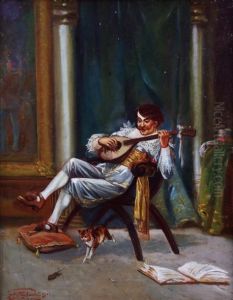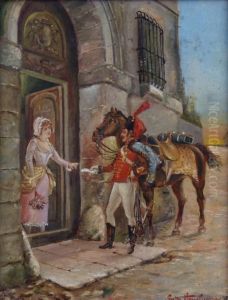Gaston Hauchecorne Paintings
Gaston Hauchecorne was a French sculptor born in 1880 in the town of Bois-Guillaume, near Rouen, in the Normandy region of France. His full name was Jean Baptiste Gaston Hauchecorne. He hailed from an artistic family, which greatly influenced his early interest and eventual career path in the arts. Despite the scarcity of detailed records about his personal life and training, it is known that he was active during the late 19th and early 20th centuries, a period that was rich in artistic evolution in France.
Hauchecorne's work is characterized by its diversity in subjects, including figures, animals, and allegorical themes, executed with a blend of realism and symbolism. This was reflective of the era's artistic movements, where there was a shift from the strictures of academic art to more expressive and experimental approaches. He was adept in various mediums, but primarily worked in bronze, stone, and wood, showcasing a remarkable ability to capture both the physicality and the emotional essence of his subjects.
Throughout his career, Hauchecorne participated in numerous exhibitions, notably the Salon des Artistes Français, a prestigious art exhibit in France where he gained recognition and accolades for his work. His sculptures not only appealed to the aesthetic sensibilities of the French public but also earned him official commissions, including war memorials, which were significant during and after the tumultuous periods of World War I.
Despite his achievements, Gaston Hauchecorne's work, like that of many of his contemporaries, became somewhat overshadowed by the avant-garde movements of the early 20th century, which pushed the boundaries of art further away from the representational and towards abstraction. Nevertheless, his contributions to French sculpture and the art world at large remain noteworthy for their technical skill, emotional depth, and the reflection of the social and historical context of his time.
Hauchecorne's legacy continued after his death in 1945, with his works preserved in various public and private collections, as well as public spaces in France. Today, he is recognized as a significant figure in the realm of French sculpture, representing the transitional period in art between the 19th and 20th centuries. His sculptures continue to be studied and appreciated for their craftsmanship and historical value, offering insights into the artistic and cultural landscape of his era.

